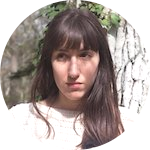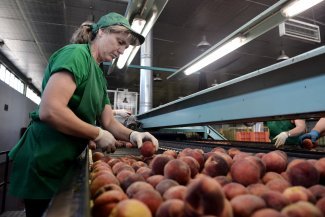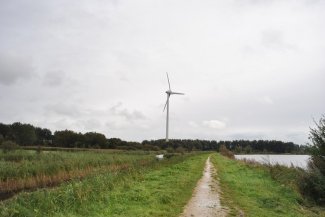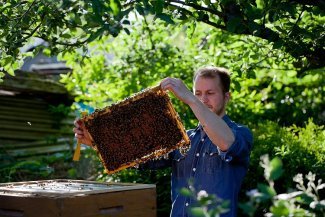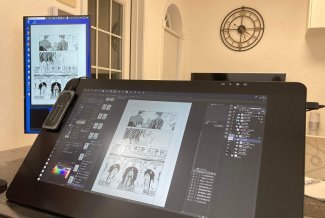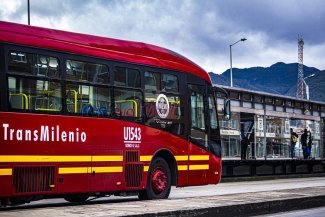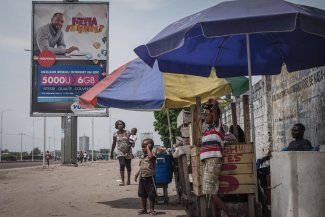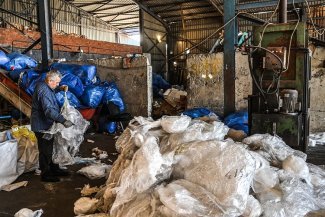High-intensity agriculture in the Netherlands, the world’s second largest agricultural exporter, has led to ubiquitous nitrate and pesticide water pollution. Today, researchers and farmers are looking into ways to transition towards more water-friendly agriculture.
In the office of Marina Vijver, environmental scientist and professor of ecotoxicology at the University of Leiden, a poster showing a Daphnia water flea dominates the wall behind her desk. Daphnia is a crustacean that lives in different types of aquatic environments, measuring up to 5mm, with an oval body covered in a (nearly) translucent carapace, from which protrudes five or six pairs of legs. It hardly provokes adorableness overload, but Vijver speaks of “the lady” with great affection.
Daphnia Magna has been dubbed a ‘canary in the coal mine’ for ecosystem studies since the changes in her growth and behaviour can be used for assessing the effects of different (man-made) pollutants. For Vijver, the tiny water flea represents a perfect benchmark for the effects of pollution on aquatic fauna.
In Leiden, a quaint town just 30 minutes from Amsterdam, Vijver researches the impact of human activities on ecosystems. “We often think everything is OK with our water: it is transparent, it is not smelly, so we are happy,” Vijver tells Equal Times. “Today it is rare to see mass deaths of the fish [in Europe]. The pollution is way more subtle.”
In the Netherlands, a global agricultural powerhouse producing a wide variety of goods, from cereals and feed crops to vegetables and flowers, the invisible, yet ubiquitous, pollution is largely due to agricultural activity. A country with a surface area of just 41,540 km2 has imposed itself as the second largest exporter of agricultural goods in the world, after the United States, in terms of export value (€96.6 billion in 2020). According to World Bank data from 2020, 53.9 per cent of land in the Netherlands is used for agriculture.
In the summer of 2022, Dutch farmers made global headlines with protests that saw them blocking roads, setting hay bales alight, and dumping manure on highways. The protests were triggered by the government’s proposals for tackling nitrogen pollution that would halve the emissions from fertilised soils. It would also lead to 11,200 farms having to close.
But intensive agriculture, limited availability of land, and high use of pesticides and inorganic fertilisers, have also impacted the quality of the country’s waters.
Although the data reported by the Netherlands for the period 2012 to 2015 has shown that approximately 88 per cent of the groundwater monitoring stations had nitrate concentrations within the EU legal threshold, 60 per cent of the freshwaters were eutrophic and 13 per cent were potentially eutrophic. Eutrophication is a process in which the water becomes enriched in nutrients, which can lead to algal blooms, resulting in oxygen depletion of the water body and affecting the entire aquatic habitat. In humans, an increased risk for certain types of cancer has been linked to the ingestion of nitrates in drinking water.
The waters in the Netherlands also register exceedances of pesticides. Research by the Dutch National Institute for Public Health and the Environment (RIVM), published in 2021 has shown that “more than half of the 216 Dutch drinking water sources have or will have problems with water quality or quantity, currently or shortly. Substances that pollute the raw water have been found in 135 drinking water sources.”
“A tipping point”
Today, the water in the Netherlands is safe to drink thanks to high-tech water purification systems. But both nutrient and pesticide exceedances are harmful to aquatic life. The EU’s water protection legislation adopted in 2000, the Water Framework Directive, and its daughter directives, set up a framework for water monitoring and protection mechanisms across the block, intending to achieve a “good status” for water bodies (the original target was 2015, but further deadlines are set for 2021 and 2027). It also defines the thresholds for many polluters; however, many scientists have been pointing out that these values don’t take into account mixtures of chemicals and interconnections between aquatic flora and fauna.
In Leiden, Vijver runs a ‘Living Lab’, a nature-embedded laboratory where real-life circumstances are simulated. Where a standardised lab setting allows for fast screenings – tests that can be replicated anywhere in the world and give us fast data – a living lab shows the impact of a substance on an entire ecosystem.
“In a traditional lab, we expose one species to one pollutant. But in nature, a species needs to hide from their predators, and search for food; they are not well fed and petted by the researcher,” says Vijver.
Leiden’s Living Lab consists of ditches; in the winter, they are opened to a nearby canal so that they can be colonised by species. During an experiment, the ditches are closed, a specific pollutant is applied to a ditch, and then the whole community is monitored for three to four months,
“There are hundreds of parasites, microbes, zooplanktons, and macroinvertebrates in a single ditch. At the beginning [of an experiment], we count them all, we quantify and describe all the connections between them – if they are competitors or have a symbiotic relationship,” Vijver explains. When they ran a test by applying one droplet of neonicotinoids (the world’s most widely used group of insecticides), she discovered that the water flea was 2,500 times more sensitive than in a classic lab experiment. The insecticide also caused a large-scale decline in freshwater insects. The decline in one species can disrupt the entire ecosystem; their competitors are likely to thrive, while their predators, left without food, will suffer.
“In the countryside, one can often see ditches covered with sheets of green algae that thrive on nutrients. But the nitrate levels in those waters turn out to be normal. The issue is that the presence of pesticides triggered a decline in algae-eating organisms, which results in an algae bloom. This an example of a broken connection,” says Vijver. “I don’t know how many connections need to be broken for us to reach a tipping point,” she warns.
Looking for solutions – with or without technology
In recent years, the EU has announced a number of legislations and strategies aiming to protect biodiversity, reduce the use and risk of chemical pesticides and make food systems more sustainable. But amid soaring energy prices and fears of food shortages triggered by the war in Ukraine, many environmental texts have been delayed or sidelined.
At the Farm of the Future, in the north-eastern province of Flevoland, researchers from the University of Wageningen work with farmers to test how some of those goals can be achieved through different cultivation methods and the use of technology. “We are trying to make food production sustainable all around. This means cutting nitrate emissions and pesticide emissions, but also enhancing biodiversity, and restoring soil health,” explains the project leader, Wijnand Sukkel, who has been working in farming systems development for the past 35 years.
Sukkel says that the current use of machinery – which increases labour efficiency but is also costly – constrained farmers to cultivate monocultures, more susceptible to pests and diseases than mixed crops systems. Crop diversity, on the other hand, helps farmers to get a higher yield with the same amount of input, water, and fertilisers, and favours biodiversity. The heavy machines have also caused soil compaction, which reduces soil fertility.
On the farm, Sukkel and his colleagues explore agri-forestry systems, experiment with the use of robots to do precise agricultural work such as pesticide spraying, and try out different solutions to preserve water. Crops are planted in strips, with flower hedges in between, every 50 metres, to preserve the diversity of insects.
“In conventional agriculture, we go in with big machines and spray everything. But usually, only a small percentage of the plants are ill. If we can be precise, and apply smaller amounts of pesticides, their use is not that much of a problem,” he says.
Sukkel is confident that the use of pesticides can be reduced by 90 per cent with precise technology, prevention and resilience systems. As for the fertiliser application, their usage could be cut by making sure there is no soil compaction. In this way, the roots can penetrate deeper into the soil and withdraw nutrients. Ultimately, this would also lead to cleaner water since the pesticide and nutrient runoffs would diminish too.
While Sukkel sees the use of better technology as a way to go forward, Joke Wierenga, a small farmer based outside the eastern city of Zwolle, believes that the solution is to change the way we plant and consume. Wierenga worked as a maths and science teacher until when seven years ago, when she visited an urban garden. “I thought to myself, ‘This is cool,’” she says. Today, she runs a one-hectare market garden.
Market gardens aim at revitalising traditional methods of agriculture, are environmentally friendly, and sell directly to the customers, bypassing the wholesalers. Wierenga runs a so-called “community-supported agriculture system (CSA).”
“A farmer runs a lot of risks when it comes to yields. In a CSA, the customers are also members of a garden for at least one year, and share the risks.” Wierenga’s garden has 100 members who pay her upfront for the produce. “I know what my income is going to be already in March, and that makes all the difference,” she explains. Every week, she notifies the members about the progress of the yields; they come by and pick their share. Some volunteer in the garden and help with planting and weeding. In her garden, Wierenga plants a wide variety of produce: there are courgettes, squashes, cabbages, fruit trees and many berries. Bees and butterflies roam around the patches of uncut grass between the crops. Synthetic pesticides and fertilisers aren’t used.
However, in the Netherlands, it is hard to make this type of agriculture commonplace. The country recorded the highest purchase price for one hectare of arable land in the EU (on average €69 632 in 2019).
Wierenga’s land is owned by the local government, and she is leasing it for only €1000 a year. But she has no guarantees that she’ll be able to work in the garden in five or ten years. With the money from the membership and educational activities with schools she organises on the farm, Wierenga is left with an income of approximately €15,000 per year.
The EU’s lavish farm subsidies amount to one-third of the bloc’s budget but are mainly destined for large landowners and not small farmers such as Wierenga. Those subsidies are a lifeline for legions of farmers, but they also lock them into the system of intensive farming. Asked about the farmers’ protests, Wierenga said she understood their struggle. “On paper, it looks like they are really rich. But all the money is locked in the land. It is like having a big house that you can’t sell to anyone because it is just too expensive. Many farmers feel stuck. It is hard for them to convert towards a different type of agriculture.”
The reform of the EU’s common agricultural policy (CAP), adopted in December 2021, should “pave the way to a fairer, greener and more performance-based CAP”. This includes better redistribution of income for small- and middle-sized farmers, and payments for environmental-friendly reforms. The CAP strategic plans, adopted by the member states, should begin in 2023. It’s to be seen to what extent they will fulfil their promise, or if the agreement has been an exercise in “greenwashing”, as already described by a number of environmental organisations.



